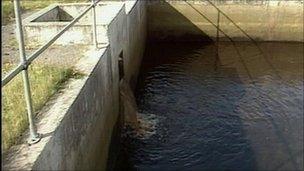Camelford water contamination: 'poisoning ignored'
- Published

Carole Cross, who died in 1994, had large amounts of aluminium in her brain
A scientist has described the Camelford water contamination as a "mass poisoning of 20,000 people that was ignored for 22 years".
Dr Chris Exley was giving evidence at the inquest of Carole Cross who lived in the area at the time of the contamination.
After hearing from two scientists, the South West Water Authority was granted an adjournment of several months.
It said it needed time to "gather its own evidence".
Mrs Cross lived in Camelford when 20 tonnes of aluminium sulphate was accidentally added to the water supply in 1988.
She was found to have high levels of aluminium in her brain after her death from a rare form of Alzheimer's.
'The worst thing'
Dr Exley, from Keele University, told the inquest in Taunton that he believed there was a link between the Camelford poisoning and Mrs Cross's death.
He said: "The level of aluminium in her brain was so high... it's not the sole cause of her death but it's probably responsible for the aggressive form and the very early onset of her disease."
Mrs Cross was 59 when she died in 1994 after suffering from cerebral amyloid angiopathy (CAA) - also known as congophilic angiopathy.

No warnings about the water contamination were given to the public for three weeks
At the time of the Camelford incident local residents were advised to mix their drinking water with orange juice to make it more palatable.
Dr Exley said that was "the worst thing" that they could have done, because the juice affected the absorption of aluminium in the body.
Residents were also told to boil the water, which Dr Exley said would have increased the concentration of aluminium.
He supported calls from the West Somerset Coroner Michael Rose for a detailed scientific study of the affect of aluminium on people who drank the contaminated water.
"We can't know what role aluminium might play in the cerebral congophilic angiopathy without designing and implementing research to specifically address this problem.
"Such research should have been instigated immediately following the incident," he said.
"The fact that there is no research, does not imply there is no problem."
The inquest also heard from neuro-pathologist Professor Margaret Esiri, who said: "It is exceptionally rare to get cerebral amyloid angiopathy on its own in someone as young as Carole Cross.
"Never have I seen it in someone of this age."
Hair turned green
Following the testimony, the South West Water Authority (SWWA) applied for the inquest to be adjourned in order for their own scientists to consider the evidence.
Granting the adjournment, the West Somerset Coroner, Michael Rose, said the inquest so far "had not been without benefit" and he was glad he started it.
Mrs Cross's husband, Doug Cross, who has long campaigned for more research into Camelford, said he welcomed the adjournment.
He said: "If the South West Water Authority wish to get more evidence, it may well help us get the answers we want.
"And if they don't it gives strength to Dr Exley and Professor Esiri's evidence.
"It is quite clear that the coroner is not prepared to give a verdict of natural causes."
The Camelford poisoning happened in July 1988 when a relief delivery driver accidentally added aluminium sulphate, used to treat cloudy water, to the wrong tank at the Lowermoor works.
That night the SWWA was inundated with about 900 complaints about dirty, foul-tasting water.
But no warnings about what had happened were given to the public for another three weeks.
Local residents reported suffering health problems, including stomach cramps, rashes, diarrhoea, mouth ulcers, aching joints and some even said their hair had turned green from copper residues.
Last week the SWWA's former chairman and chief executive Keith Court said the firm had not wanted to create "undue alarm" by telling people in the north Cornwall area what had happened.
- Published3 November 2010
- Published2 November 2010
- Published1 November 2010
- Published1 November 2010